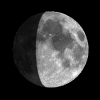Bluegrass Amateur Astronomy Club (Lexington, KY) |
By Rick Schrantz
Quite frequently, club members are asked "What telescope should I buy"? Generally, people who ask us this question are in the market for a beginner's telescope for themselves or a child. They want to know how much money they should spend, and if the "600 power" model they saw at K-Mart is a good deal. First of all, there are some points to consider before choosing a telescope. Don't be in a hurry. The universe will wait for you!
First, start to familiarize yourself with the sky. Using a star map, learn to recognize some constellations, and learn a little bit about different types of objects in the sky (such as galaxies and planets). Be able to recognize and point out various planets if they are visible (such as Venus, Mars, Jupiter, and Saturn). From a dark sky, look for meteors and satellites. You can see a lot with the naked eye.
If you have binoculars, use them too. You can see a lot more in the sky with them. Even a pair of cheap 10X50's will show a wealth of objects.
Attend a local "star party". The BGAAC has free monthly observing sessions at Raven Run Nature Sanctuary (in southeast. Fayette County, KY). They are held from March through November (weather permitting). You will be able to look through several different kinds and sizes of telescope when it gets dark enough. Anywhere from 30 to as many as 150 people attend these events. Contact Raven Run (859 272-6105) for details.
Pick up a couple of astronomy magazines and flip through the advertisemants. These will show many different types of telescopes available. Two good magazines are Sky and Telescope and Astronomy.
Our recommendation for a beginner's telescope is a 6-inch f/8 Dobsonian reflector type (or even an 8-inch f/6). These types of telescopes are available from Meade, Orion, and Celestron, and cost about $300 to $500 (all mail order). However, these telescopes are not perfect. They must be optically aligned when they arrive, and they can be modified by the owner to produce smoother motions. You must have some accessories with these telescopes to make them most useful. Some of these scopes come with the accessories standard or as a low-cost option. The accessories you need:
a. A zero power finder such as a Telrad or Rigel Quick-Point - Pointing a telescope is not a trivial matter. The small finders that come with them are usually not very useful.
b. At least two reasonably good quality eyepieces (a low power 25 to 32 mm, and a higher power 8 to 12 mm) - The Plossl design is very popular and competitive. Meade, Orion, and Celestron offer inexpensive Plossl eyepieces.
c. Some sort of star chart - After looking at the moon and bright planets, finding things in the sky can be a challenge.
If you are at all mechanically inclined, you can build your own telescope. It is not too hard, but it does take time and planning. You will not save money over a commercial telescope, but you will have an instrument that works better, provides better images, and is customized for your needs. The only tools required are: a radial-arm or table saw, a power screwdriver, a router with a radius arm for cutting circles and curves, an electric drill with bits, and a hole saw. You will be working with fine plywood (such as Russian Baltic Birch) for strength, a cardboard tube meant for pouring concrete pillars, and kitchen counter-top laminate. You will have to purchase a primary and secondary mirror, a focuser, a spider vane, and a mirror holder. If you are truly interested, one of our members will help guide you. It is also possible to make the primary mirror yourself: please see our section
which describes the process in some detail.
Lexington Clear Sky Chart
 Raven Run Clear Sky Chart 
|

|